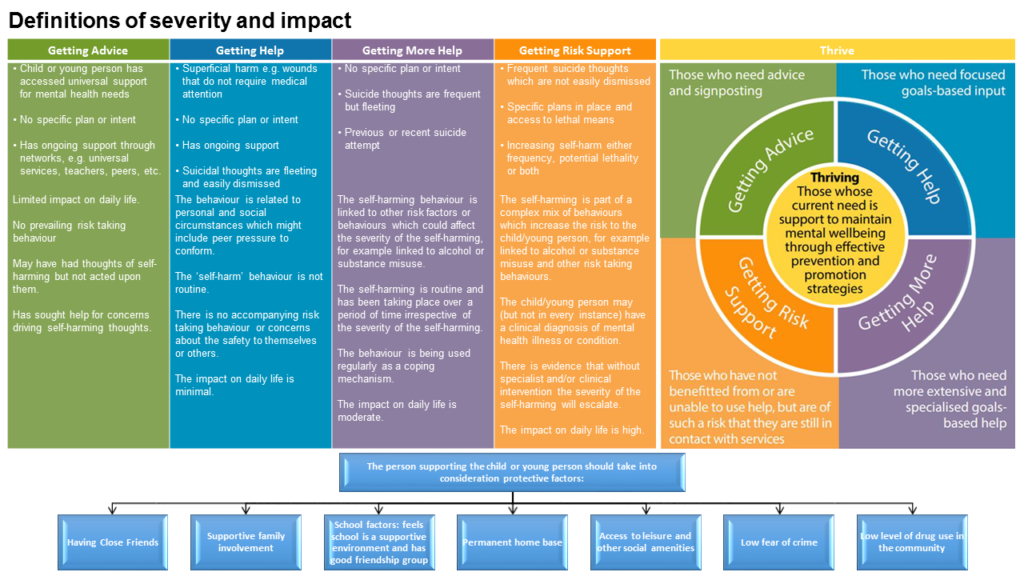Additional Information for Schools
Residential settings
There is likely to be increased risk for a young person to self-harm when in residential care. As the environment might make them feel more vulnerable especially if it is a new setting. Some additional triggers such as;
- loneliness
- separation from parents/carers/friends/familiar routines and places
- possible issues with bullying
- isolation from peer group
- being in an unfamiliar environment
These could all be relevant factors which could increase stress and anxiety. It is important to ensure that a risk assessment is in place (see appendix 3), Residential staff will need specific training around self-harm so they can identify possible signs and know how to respond. Good liaison with mental health professionals and services is critical and lines of communication need to be clearly established. Strategies would need to focus on helping the pupil build resilience such as providing a secure attachment figure, maintaining education provision, promoting contact with family including siblings, promoting talents and interests, promoting friendships and helping the young person manage their emotions and take responsibility. Positive role models who can show empathy and warmth and be non-judgemental as well as providing structure and support will be protective factors.
Roles and responsibilities
The Governing Body
The governing body has the legal duty to safeguard and promote the welfare of their pupils. Schools may have a nominated governor for safeguarding who will have an oversight of the provision for pupils who self-harm.
The Headteacher
The Headteacher has responsibility for establishing effective safeguarding procedures with regard to self-harm, thereby ensuring the duty of care of pupils and staff. This could be supported by the implementation of a self-harm policy and using the self-harm guidelines checklist for schools (see Self-Harming Checklist).
Staff
Pupils may choose to confide in any member of school staff if they are concerned about their own welfare, or that of a peer. Pupils may present with injuries to first aid or reception staff in the first instance and it is important that these frontline staff are aware that an injury may be self-inflicted, and that they pass on any concerns. School staff may experience a range of feelings in response to self-harm in a pupil such as anger, sadness, shock, disbelief, guilt, helplessness, disgust and rejection. However, in order to offer the best possible help to pupils it is important to try and maintain a supportive and open attitude – a pupil who has chosen to discuss their concerns with a member of school staff is showing a considerable amount of courage and trust. The member of staff will:
- Avoid saying ‘self-harmer’ – it is important to talk about a behaviour and not label a person, so say ‘self-harming behaviour’ instead
- Endeavour to enable pupils to feel in control by asking what they would like to happen and what help they feel they need
- Reassure them that there is help available
- Listen actively (See appendix 5 ‘How do I start a conversation with a pupil’)
- Be non-judgemental
- Avoid asking a pupil to display injuries or scars or describe what they do
- Avoid making assumptions or stereotyping behaviour, don’t say ‘people generally/ usually…’ everyone is different
- Never refer to self-harm as a ‘failed suicide attempt’
- Avoid asking a pupil to stop self-harming as this may be the only coping strategy they have
- Be re-assuring and support them to seek help
- Staff must not work outside their remit.
Confidentiality/information sharing
Pupils are entitled to expect personal information to remain confidential. This means that the information should not be disclosed to anyone including the pupil’s parents/ guardians unless, having considered all the circumstances, it is considered necessary for one of the following reasons:
- In the interest of health and safety of the child.
- For the prevention or detection of crime
Even then care must be taken to limit disclosure to only those who ‘need to know’. Pupils should be made aware that confidentiality will be maintained but that it cannot always be guaranteed.
If a member of staff considers that a pupil is at risk of harming themselves or others then confidentiality cannot be kept. It is important not to make promises of confidentiality that a member of staff cannot keep, even though the pupil may put pressure on them to do so. If this is explained at the outset of any meeting the pupil can make an informed decision as to how much information they wish to divulge.
Staff should be trained to identify the signs of self-harm (please see LINK TO TRAINING). Any member of staff who is aware of a pupil engaging in or suspected to be at risk of engaging in self-harm should follow school policies and procedures and consult with the Designated Safeguarding Lead (DSL). In an emergency situation, members of staff should assess the situation, administer first aid and/or call for an ambulance for emergency assistance.
Once informed, the DSL will decide on the appropriate course of action. This may include:
- Contacting parents / carers
- Arranging professional assistance e.g. doctor, nurse, social services
- Arranging an appointment with a counsellor
- Removing the pupil from lessons immediately if remaining in class is likely to cause further distress to themselves or their peers
- Remaining with the pupil at all times if they are acutely distressed
Risk assessment.
It is important to ensure that there is a risk assessment in place which relates to the self-harming behaviour, possible triggers and strategies to be used to minimise risk. The example risk assessment in appendix 3 is for guidance only and it needs to be adapted according to individual need.
Liaison with support services which may include the Healthy Child Service, Compass REACH and specialist Child and Adolescent Mental Health Service (CAMHS).
Schools should now follow the North Yorkshire Pathway of support for children and young people who deliberately self-harm. The Pathway has defined the severity and the risk and/or impact of self-harming as follows.

Meetings
Any meetings with a pupil, their parents or their peers regarding self-harm should be recorded in writing including:
- Dates and times
- An action/health plan
- Concerns raised
- Details of anyone else who has been informed
- Risk assessment (See appendix 3)
This information should be stored in the pupil’s confidential child protection/safeguarding file.
Issues regarding contagion, multiple or copycat behaviours
When a pupil is self-harming it is important to be vigilant in case close contacts of this individual are also self-harming. Occasionally schools or residential settings may discover that a number of students in the same peer group are harming themselves. Self-harm can become an acceptable way of dealing with stress within a peer group and may increase peer identity. This can cause considerable anxiety in school staff, parents and carers, as well as in other pupils. Each individual may have different reasons for self-harming and should be given the opportunity for one to one support; however, it may also be helpful to discuss the matter openly with the group of pupils involved. In general it is not advisable to offer regular group support for pupils who self-harm. Where there appears to be linked behaviour or a local pattern emerging, a multi-agency strategy meeting should be convened.
It is important to encourage pupils to let staff know if one of their group is in trouble, upset or showing signs of self-harming. Friends can worry about betraying confidences so they need to know that self-harm can be very dangerous and that by seeking help and advice for a friend they are taking responsible action and being a good friend. They should also be aware that their friend will be treated in a caring and supportive manner. The peer group of a pupil who self-harms may value the opportunity to talk to a member of staff either individually or in a small group.
Managing PE/Sport Lessons
Pupils who self-harm should be actively encouraged to participate in sport. PE/Sport colleagues may need to be aware that so adjustments to normal clothing guidelines can apply such as a need for a long sleeve top and alternative changing areas.








 View all our news
View all our news